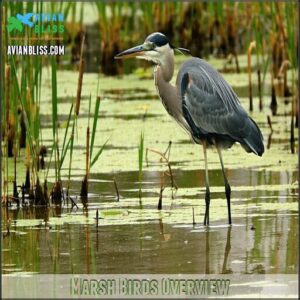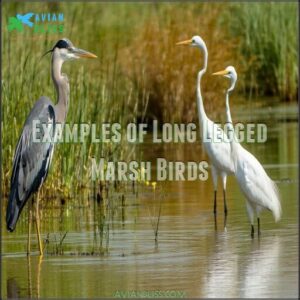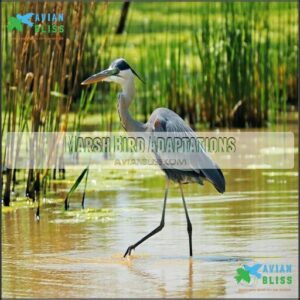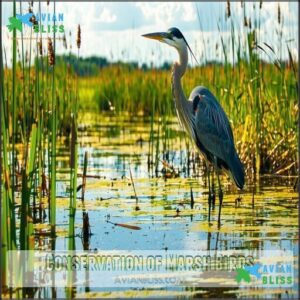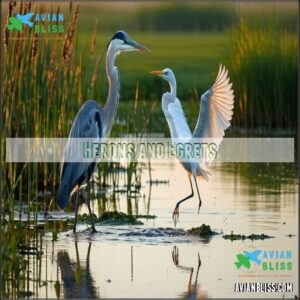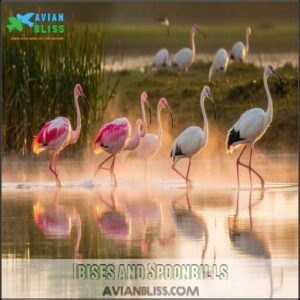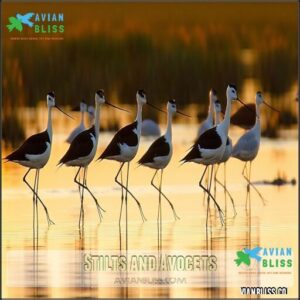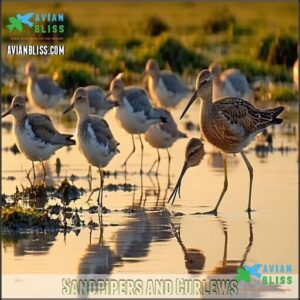This site is supported by our readers. We may earn a commission, at no cost to you, if you purchase through links.
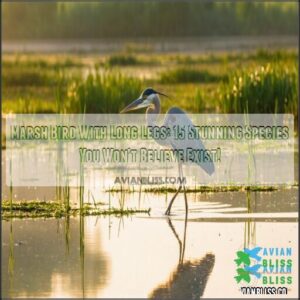
Their legs help them stay steady on soft mud, keeping their feathers clean and their eyes on small fish or insects. From the Great Blue Heron to the delicate Black-necked Stilt, each species has evolved unique traits to thrive in marshy habitats.
You won’t believe how these adaptations make them masters of the wetlands—wait till you meet the spoonbill!
Table Of Contents
- Key Takeaways
- Marsh Birds Overview
- Long Legged Marsh Birds
- Marsh Bird Adaptations
- Conservation of Marsh Birds
- Marsh Bird Species
- Frequently Asked Questions (FAQs)
- Do marsh birds have long toes?
- What does a marsh bird look like?
- Do birds live in marshlands?
- What birds live in a marsh?
- What birds have long legs?
- Can a marsh bird swim?
- What birds have long legs in the marsh?
- What is the name of the bird with long legs?
- What are the long-legged birds near water?
- What are marsh birds called?
- Conclusion
Key Takeaways
- You’ll find many marsh birds have evolved specialized long legs that keep their bodies dry while wading through shallow waters, allowing them to access food sources unavailable to shorter-legged species.
- Great Blue Herons, Snowy Egrets, White Ibises, and Black-necked Stilts are standout examples of long-legged marsh birds, each with unique adaptations for their wetland habitats.
- These birds’ physical features work together as nature’s toolkit – their specialized bills complement their long legs, creating perfect systems for hunting fish, crustaceans, and insects in muddy or watery environments.
- Conservation of marsh bird habitats is critical as wetlands are disappearing rapidly, with up to 90% of coastal marshes at risk by century’s end due to climate change, pollution, and human development.
Marsh Birds Overview
You’ll find marsh birds with their distinctive long legs perfectly adapted for wading through shallow waters, allowing them to access food sources that would otherwise remain out of reach.
Marsh birds elegantly wade through shallow waters, their long legs unlocking hidden food treasures beneath the surface with effortless grace.
Their specialized physical features, from varied bill shapes to impressive wingspans, help these remarkable creatures thrive in wetland ecosystems.
They’ve developed unique hunting techniques for catching fish, crustaceans, and insects, which enable them to survive in their habitats.
Physical Characteristics of Marsh Birds
Wading through wetlands with grace, marsh birds display physical characteristics perfectly adapted for their aquatic lifestyle.
You’ll notice these remarkable features that help them thrive in challenging environments:
- Leg Length Variation – From moderately tall to impressively elongated, these structures allow birds to access different water depths without getting their bodies wet.
- Beak Shape Diversity – Specialized bills evolved for specific feeding strategies, whether they’re probing mudflats or spearing fish with lightning precision.
- Wing Span Control – Their wings provide exceptional maneuverability through dense marsh vegetation, balancing both power and agility.
- Feather Coloration – Colors range from cryptic browns for camouflage to striking whites and blues for territorial displays and courtship.
- Eyesight Accuracy – Exceptional vision helps these long-legged wading birds spot underwater prey with remarkable precision, even in murky waters.
These physical traits work together like nature’s perfect toolkit, allowing marsh birds to exploit their ecological niche with impressive efficiency.
Habitat and Distribution of Marsh Birds
While marsh birds showcase fascinating physical characteristics, their homes tell an equally compelling story.
You’ll find these longlegged wonders across diverse wetland ecosystems throughout North America and beyond.
Marsh habitats range from coastal saltmarshes to inland freshwater wetlands, each supporting unique bird communities.
The geographic range of many wetland birds spans impressive distances, with some species maintaining year-round territories while others follow established migration patterns.
When exploring these ecosystems, you’ll notice:
- Shallow freshwater marshes teeming with life and feeding opportunities
- Coastal wetlands serving as essential nurseries for juvenile birds
- Prairie potholes bustling with breeding activity in spring
- Mangrove forests protecting birds during harsh weather events
- Mudflats exposing rich food resources during tidal changes
Sadly, habitat loss threatens these remarkable birds.
North America has lost nearly 25% of its wetlands since 1984, dramatically impacting marsh bird populations and their distribution.
Climate impacts further challenge these specialized wetland birds.
Some marsh birds, like the territorial marsh wren, are known for their aggressive defense of nesting sites.
Diet and Foraging Techniques of Marsh Birds
Hungry birds with long legs have developed remarkable hunting strategies in their marsh habitats.
You’ll notice how these wetland specialists employ diverse techniques to secure their meals efficiently.
| Bird Type | Hunting Strategy | Dietary Adaptations |
|---|---|---|
| Herons | Stand motionless before lightning-fast strikes | Fish, frogs, crustaceans |
| Ibises | Probe mud with curved bills | Small crustaceans, insects |
| Egrets | Patient stalking through shallow water | Fish, amphibians, reptiles |
When you visit marshes, you might spot these birds displaying their foraging efficiency—some remain perfectly still while others actively stir sediment to flush out prey.
Their specialized bills complement their long legs, creating the perfect toolkit for prey specialization.
What’s fascinating is how their diets shift seasonally; many supplement primarily aquatic diets with seeds and vegetation during drier periods.
This dietary flexibility guarantees their survival year-round, showcasing the remarkable adaptations of these elegant marsh residents, with a clear example of diverse techniques to secure meals, and an ability to employ efficient hunting strategies.
Long Legged Marsh Birds
You’ll be amazed by these marsh birds with their remarkably long legs that allow them to wade through water without getting their bodies wet while searching for food.
Their specialized limbs aren’t just for show—they’re nature’s perfect adaptation for traversing muddy terrain, reaching deeper water areas, and efficiently capturing prey that shorter-legged birds simply can’t access, which is a perfect adaptation and allows them to efficiently capture prey.
Examples of Long Legged Marsh Birds
Let’s move from understanding marsh birds generally to exploring specific standouts with impressive stilts beneath them.
Stepping into wetlands, you’ll encounter remarkable long-legged marsh birds that seem almost otherworldly. These wading bird champions use their extraordinary legs to navigate challenging habitats with grace.
Five spectacular species you might spot include:
- Great Blue Herons with slate-gray plumage and impressive heron leg length (4-5 feet tall)
- Snowy Egrets showcasing distinctive bright yellow egret foot color against pure white feathers
- White Ibises demonstrating curved ibis bill shape perfectly designed for probing mudflats
- Whooping Cranes reaching nearly 5 feet in crane height with brilliant white plumage
- Black-necked Stilts flaunting dramatic black-and-white patterns with eye-catching pink stilt leg color
Each longlegged bird has evolved specialized adaptations that allow them to thrive where shorter-legged species simply couldn’t manage, making them true marsh birds with unique characteristics.
Advantages of Long Legs in Marsh Birds
Marveling at how marsh birds thrive in wetlands? Their long legs are nature’s secret weapon, offering benefits you’ve probably never considered.
These specialized limbs are all about survival, from feeding to fleeing predators.
With wading efficiency unmatched by shorter-legged creatures, longlegged birds like herons and egrets easily access deeper water full of untapped food resources. That means they outcompete others for fish, insects, and small amphibians.
Their remarkable leg morphology also keeps their feathers dry and promotes thermoregulation—because nobody likes soggy feet!
Long legs give these wading birds serious advantages:
- Foraging reach that expands feeding options in deeper marshes.
- Predator avoidance, keeping their bodies elevated and safe from land threats.
- Stability support for traversing muddy substrates without losing balance.
Nature knows best—those marsh bird legs are purpose-built marvels!
Use of Long Legs in Wading and Running
Early morning in a wetland, long legs are a marsh bird’s secret weapon. Their Leg Morphology guarantees incredible Wading Efficiency as birds like herons use careful steps that avoid disturbing their surroundings.
This stealth aids hunting while traversing muddy terrain with confidence.
When danger strikes, those same bird leg structures transform into tools of escape, offering impressive Running Speed across uneven ground. With sharp Balance Control, these birds adapt seamlessly to their environment.
| Feature | Wading Use | Running Use | Benefit |
|---|---|---|---|
| Leg Morphology | Steady movement | Swift escapes | Efficient navigation |
| Balance Control | Precise footing | Stability | Enhanced adaptability |
| Long Legs | Shallow water access | Faster running | Versatile mobility |
| Habitat Navigation | Complex wetlands | Safer from predators | Survival-focused design |
Marsh Bird Adaptations
You’ll be amazed at how marsh birds are perfectly designed for their unique habitats.
From their long legs for wading to specialized beaks for precise foraging, these adaptations guarantee survival in challenging wetland environments.
Physical Adaptations of Marsh Birds
Standing in a marsh, you’d notice how marsh birds are built for their watery world.
Built for life in wetlands, marsh birds master wading, blending, and hunting with precision in their watery world.
Their remarkable physical adaptations help them thrive where others would flounder.
Here are five key features:
- Leg Length and Structure: Long, thin legs keep their bodies above water and reduce drag when wading.
- Feather Coloration and Coating: Dense, water-repellent feathers shield them from the elements, offering insulation and buoyancy while blending into the environment.
- Beak Morphology: From spear-like heron beaks to upturned avocet bills, each beak design perfectly matches the bird’s feeding needs and strategy.
- Wing Adaptations: Lightweight, hollow bones and strong wings deliver efficient, graceful flight through dense vegetation.
- Sensory Perception: Exceptional eyesight lets them spot prey underwater despite glare or murky conditions.
These adaptations turn marsh birds into masters of their unique habitat.
Behavioral Adaptations of Marsh Birds
Marsh birds aren’t just about striking features—they’re behavioral geniuses too. Their actions are adapted for survival in challenging wetlands, blending form with function in fascinating ways.
Take their social behavior, for example. Many species nest in colonies, gaining safety in numbers. Sharing space with others, they keep predators at bay while exchanging cues to detect danger. Predator avoidance becomes a community effort!
When it comes to foraging, these birds have fine-tuned techniques. Long-legged waders like Great Blue Herons stand statue-still, conserving energy until snapping up unsuspecting prey. Others, like the White Ibis, rely on synchronized group movements, probing muddy waters together for efficiency. Fancy table manners, right?
Migration patterns offer another marvel. Whooping Cranes use teamwork in real-time, with seasoned elders leading the rookies to ancestral nesting grounds. Many marsh bird species form lifelong monogamous bonds, which is vital for breeding success.
- Great Blue Herons master patience during prey capture.
- White Ibis showcase teamwork while foraging.
- Whooping Cranes demonstrate wisdom in navigation.
Unique Features of Marsh Birds
Marsh birds are fascinating creatures, perfectly built for wetland life. Their long legs aren’t just for show—they help birds wade through water silently, avoiding detection by prey. Every step is like a chess move, deliberate and precise.
The variety in bill morphology is another standout. From herons’ spear-like beaks designed for fishing to the curved bills of ibises, wetland birds display genius feeding strategies.
Their plumage coloration is nature’s camouflage, allowing them to blend into marshy surroundings. Bright whites, muted browns, and vibrant blues serve both beauty and survival.
Add sharp sensory perception, with eyes able to track prey underwater, and you’re looking at survival machines. They’ve even honed distinct vocalizations for mating or warnings.
Marsh birds show that wetlands aren’t just homes, but evolutionary masterpieces.
Conservation of Marsh Birds
You’ve probably noticed that marsh birds rely on wetlands to nest, feed, and thrive, but these essential habitats are disappearing fast.
Protecting these long-legged wonders means tackling threats like habitat loss, pollution, and climate change with effective conservation efforts.
Threats to Marsh Bird Populations
Marsh birds with long legs frequently face a range of challenges that threaten their survival.
Their fragile wetland homes are under siege by a combination of climate change, pollution, and human activities. Rising sea levels could drown up to 90% of coastal marshes by the century’s end. Species like the saltmarsh sparrow see their nests flooded, leading to an 87% population decline in 25 years.
Key threats include:
- Climate change disrupting water levels and temperatures.
- Pollution impacts poisoning food sources from industrial and agricultural runoff.
- Human disturbance, like development, destroying breeding areas.
Add to this increased predation and disease, and it’s clear why these birds are in trouble. Supporting wildlife conservation efforts can help mitigate these issues. Addressing these threats through conservation could offer hope for marsh bird populations.
Habitat Loss and Fragmentation
Wetlands are disappearing faster than you’d think, leaving long-legged marsh birds struggling to adapt. The Habitat Fragmentation Effects are devastating, with species losing their breeding and foraging spaces due to relentless human activities.
Here’s the reality of Wetland Loss Causes:
- Agricultural development drains 45,000 acres of marshland annually.
- Urban sprawl chops wetlands into isolated "habitat islands," reducing resources for species.
- Over 85% of coastal wetlands have vanished since the 1950s.
- Climate change alters water cycles, degrading habitats critical for survival.
These disruptions lead to Species Displacement, pushing herons and ibises into unsuitable areas. To combat this, the Army manages lands to provide refuge for these species. Without bold Conservation Strategies, we risk losing these iconic birds forever.
Conservation Efforts for Marsh Birds
Protecting marsh birds isn’t just about saving beautiful creatures—it’s about preserving delicate ecosystems.
Conservation efforts like habitat restoration rebuild wetlands, providing safe nesting grounds for species like Saltmarsh Sparrows.
Wetland conservation also combats climate change effects, such as sea-level rise, which threatens marsh bird habitats.
| Effort | Focus Area | Why It Matters |
|---|---|---|
| Habitat Restoration | Wetlands | Supports breeding and feeding sites |
| Invasive Species Control | Fragile ecosystems | Prevents habitat degradation |
| Pollution Control | Water quality | Reduces toxins affecting food webs |
| Public Awareness | Community involvement | Inspires local conservation actions |
Every donated dollar or volunteer hour makes a ripple in bird conservation.
Marsh Bird Species
You’ll find marsh bird species in wetlands worldwide, each uniquely adapted for life in these rich environments.
With their long legs and specialized bills, these birds have ingenious ways to hunt, forage, and thrive in shallow waters, utilizing their long legs to great advantage.
Herons and Egrets
Herons and egrets stand as graceful ambassadors of marshlands, each bird with long legs showcasing an orchestra of natural engineering.
These heron species and egret identification tips highlight key features you can’t miss:
- S-shaped necks—spring-loaded for snatching prey with jaw-dropping precision.
- Unique bills—a yellow dagger for Great Egrets, a blue-black tool for Little Blue Herons.
- Stunning Egret Plumage—snowy whites meeting blue-gray hues.
- Leg Adaptations—perfect for wading, keeping feathers dry.
- Foraging Strategies—from patience to dancing, like the Reddish Egret’s playful canopy feeding.
Their classification shows that egrets are types of herons.
Heron diets range widely, spotlighting their wetland versatility.
Ibises and Spoonbills
Ibises and spoonbills will sweep you off your feet with their graceful movements and fascinating adaptations.
Their long legs keep their feathers dry while they forage elegantly through marshes. Ibises, like the White Ibis, boast curved bills designed for probing mud, while spoonbills, such as the Roseate Spoonbill, use their flat, wide beaks to sift through water for food.
Did you know that the Scarlet Ibis’ vibrant red plumage comes from their diet? These birds are highly social, often flocking together.
Consider specialized Ibis birdseed for superior health. Understanding their behaviors and conservation status helps protect their habitats.
- Highlights:
- Unique ibis bill morphology and spoonbill feeding habits.
- Stunning plumage variations.
- Social behaviors enhance ibis group dynamics.
Stilts and Avocets
Stilts and avocets, two mesmerizing marsh bird species, showcase stunning adaptations. With their long legs, they gracefully navigate shallow waters, embodying the marvels of stilt morphology.
These wading birds captivate with their plumage variation and unique features like the Black-necked Stilt’s needle-like bill and the American Avocet’s elegantly upturned bill.
To assist in proper stilt bird identification, resources are available.
| Species | Feeding Strategy | Conservation Status |
|---|---|---|
| Black-necked Stilt | Precise pecking | Least Concern |
| American Avocet | Sweeping technique | Stable |
| Pied Avocet | Sediment probing | Recovering |
Avocet feeding involves sweeping their bills through water, while stilts opt for pinpoint pecks.
Their nesting habits thrive in protected, shallow wetlands essential to their survival.
Sandpipers and Curlews
In the context of sandpipers and curlews, these marsh waders truly know how to navigate wetlands with style.
Their long legs help them stride through mud and water like pro athletes on a mission. Spotting them often starts with shorebird identification, focusing on their unique behaviors.
Sandpipers are known for rapid pecking, while curlews use their elegantly curved beaks to dig deep into the sediment for insects and crustaceans.
During migration, they rack up impressive mileage, traveling thousands of miles between breeding and wintering grounds. It’s like nature’s ultimate road trip, but unfortunately, shorebird conservation efforts face hurdles with shrinking habitats.
Their thin, efficient limbs are masterpieces in evolutionary refinement, minimizing energy use while maximizing feeding ecology.
Whether you’re observing curlew behavior or admiring a sandpiper’s foraging finesse, these shorebirds exemplify survival with flair.
Frequently Asked Questions (FAQs)
Do marsh birds have long toes?
Yes, marsh birds often have long toes, helping them balance on muddy or uneven surfaces.
Their toes distribute weight efficiently, preventing them from sinking as they forage for food in wetland habitats.
What does a marsh bird look like?
Picture a marsh bird as nature’s elegant wader, with long legs like stilts, sharp beaks for hunting, and feathers ranging from sleek whites to earthy browns.
Masters of wetland survival, blending beauty with purpose.
Do birds live in marshlands?
Birds thrive in marshlands, enjoying the abundant food, shelter, and nesting spots these wetlands offer.
From wading in shallow waters to nesting in reeds, they’re perfectly adapted for life in these dynamic, water-rich habitats, utilizing the environment to their advantage with abundant food.
What birds live in a marsh?
In marshes, you’ll find a variety of fascinating birds, like herons, egrets, ibises, sparrows, and wrens.
They thrive here using their long legs, sharp beaks, and unique adaptations to navigate and hunt effectively.
What birds have long legs?
Wading through mysterious wetlands, you’ll spot herons, egrets, stilts, and cranes flaunting their impressive stilts.
These birds’ long legs help them navigate water while keeping their bodies dry during hunting expeditions.
Can a marsh bird swim?
Yes, you’ll find many marsh birds can swim quite well.
Some paddle across water surfaces, while others dive completely underwater.
Their waterproof feathers and specialized feet make swimming a natural part of their wetland lifestyle.
What birds have long legs in the marsh?
Like sentinels of the wetlands, you’ll find herons, egrets, bitterns, ibises, stilts, and cranes patrolling the marshes. Their elongated legs help them wade through water without getting their bodies wet.
What is the name of the bird with long legs?
You’ll find several birds with long legs in marshes, including herons, egrets, ibises, stilts, and cranes.
Each species uses its impressive stems to wade through water while hunting for fish and other aquatic prey.
What are the long-legged birds near water?
You’ll spot herons, egrets, ibises, and stilts wading near shorelines. These water-loving birds use their long legs to navigate shallow depths while hunting for fish, crustaceans, and other aquatic prey.
What are marsh birds called?
Ever wondered about those graceful waterbirds?
Marsh birds are called herons, egrets, bitterns, ibises, rails, and cranes.
You’ll see these wading birds using their impressive legs to navigate wetland habitats with remarkable precision.
Conclusion
With wetland habitats declining by 54% globally since 1900, your awareness of marsh birds with long legs has never been more essential.
These remarkable waders—from the majestic Great Blue Heron to the peculiar Roseate Spoonbill—demonstrate nature’s perfect engineering.
Next time you’re near wetlands, bring binoculars and watch how these birds navigate their watery homes with graceful precision.
You’ll gain a new appreciation for how these marsh birds with long legs have mastered life between land and water.

